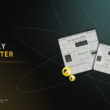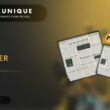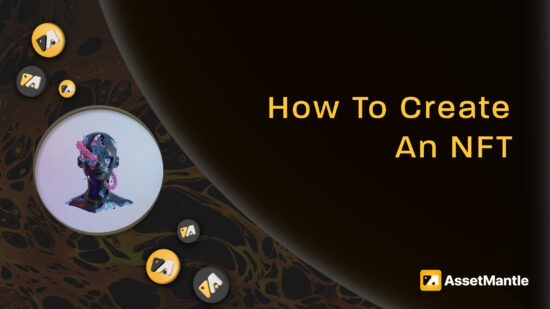Non-fungible tokens, or NFTs, have received a lot of attention recently, and it is not surprising. Especially when you hear stories about artists who have made tens of millions of dollars selling an NFT.
NFTs have skyrocketed in popularity in just the last year when you look at the market. According to DappRadar, the trade-in NFTs increased from $100 million in 2020 to $22 billion in 2021, and the total value of the top 100 NFTs is $16.7 billion.
What is an NFT?
NFTs are virtual assets with a unique identity, and whose ownership can be authenticated on the blockchain. Every NFT is non-fungible, meaning there is no other asset like it on a blockchain, and neither can it be duplicated.
The most common NFT assets include photos, videos, music, GIFs, and collectibles. However, any digital file format can be minted as an NFT on a blockchain.
NFTs have value because there is only one version of the created assets. In other words, an NFT has only one owner at any given time. No one can fake ownership or copy an NFT on a blockchain. Given the non-fungible nature of NFTs, the creators/owners of NFTs (particularly rare and exclusive ones) can set premium rates for their assets, because of the large supply-demand gap in the market for that particular asset.
Who Can Create an NFT?
People with a small amount of money, and some sort of digital asset or art can create an NFT. Today’s NFT platforms offer tools that allow you to create all kinds of NFTs and attach unlocked content to your files. Whether you’re an artist, collector, musician, entrepreneur, or company, you can easily create your NFT using the tools available on the NFT marketplace.
How to Create an NFT as a Beginner?
Let’s look at the basic steps to create your own NFTs. Keep in mind that this does not mean a comprehensive guide.
There are various ways to do this depending on the NFT marketplace you choose, the value you wish to deliver, and more. So, use these tips as general guidelines.
1. Decide What Type of NFT You Want to Create
Before you can get into figuring out how to create an NFT you need to decide what kind of NFT you want to make.
NFTs are versatile, and you have many options for what you want to make. Some of your options include artwork, event tickets, memes, media and music, games, and metaverse land.
You can even make an NFT for actual life items, such as a collection of beloved figures or a signed photo of a celebrity.
They are often in the form of images, audio, or video files, such as JPG, PNG, MP4, MOV, etc.
STEPN is a great example of this. The project dropped a collection of 10,000 sneakers NFTs. For every NFT minted, there is a physical pair of sneakers stored in their vault. Users could claim their physical sneakers anytime upon burning their NFTs.
If you decide to make a simple NFT, you will not necessarily need a developer. But if your NFT is something more complex, such as an in-game asset, or requires a convoluted smart contract (terms of sale), you may need a developer’s help.
Some NFT marketplaces, like MantlePlace, take NFT creation to the next level by offering never-seen-before features, like split royalties and mutable metadata, to users without having to code!
When creating your first NFT, think about how you can add value to your audience. If you already have a business, you can try creating a loyalty card or unique promo code, and you can always hire an artist to create custom art for you.
2. Choose an NFT Marketplace
For anyone who wants to learn how to create an NFT, choosing the right NFT marketplace is very important because there are plenty of NFT markets to choose from. Every NFT Marketplace has its pros and cons, so be sure to do your research before choosing.
NFT platforms make it easy for new creators to jump into the world of NFTs. Some require you to authenticate or write your NFT on the blockchain, while others, like MantlePlace, provide the option of lazy minting. In lazy minting, you can steer away from minting fees by placing your NFT for sale without actually writing it on the blockchain.
Your choice of the marketplace should stem from the ecosystem you believe in or wish to build on top of. Below is a table that shows different NFT marketplaces and their ecosystem.
| NFT MARKETPLACE | NETWORK/ECOSYSTEM |
|---|---|
| MantlePlace | Cosmos |
| OpenSea | Ethereum |
| Magic Eden | Solana |
| Paras | Near |
3. Set Up a Non-Custodial Crypto Wallet
A non-custodial wallet is crucial for all NFT creators.
An important consideration when choosing a wallet is whether it is compatible with the blockchain and the NFT marketplace you want to use to create your NFTs.
When setting up a wallet, it is highly recommended that you securely and privately note down your secret recovery phrase (a.k.a. mnemonic seed phrase).
Below are a few reputed wallets for different chains.
| WALLETS | NETWORKS |
|---|---|
| MantleWallet | Cosmos |
| Keplr | Cosmos |
| Phantom | Solana |
| MetaMask | Ethereum |
4. Buy Crypto Through an Exchange
A very important part of learning how to create an NFT is knowing that you will have to pay network fees when making them unless you take the lazy minting route.
Once you’ve made the wallet, it’s time to buy some cryptocurrency so you can pay the network fees required to create an NFT.
The best way to do this, for beginners, is to open an account with a reputable exchange, such as Binance, Gate, or Huobi. This process is quite simple and can be completed on your smartphone. Next, buy the relevant cryptocurrency and withdraw them to a compatible wallet.
If you already have cryptocurrencies, you can even choose to swap them through liquidity pools. For instance, you can swap $OSMO for $MNTL on Osmosis if MantlePlace is your go-to marketplace.
5. Connect your wallet to the NFT platform and create an NFT
There are a lot of different NFT platforms operating on many different blockchains, so you would have to select one of the NFT platforms operating on your preferred blockchain.
People who are planning to create an NFT in the Cosmos ecosystem should consider trying out MantlePlace as it is one of very few interchain NFT platforms.
Depending on the NFT platform you use, the process required to create an NFT would vary. Although most NFT platforms do offer a simple UI/UX, the Mantle team went above and beyond to make the NFT creation process as intuitive as possible for web 2.0 users.
Conclusion
To sum up, anyone with a few minutes of internet study can create their first NFT. With solutions like lazy minting offered by marketplaces like MantlePlace, creators now do not even need a lot of capital to drop their collection.
However, launching a full-fledged NFT project and marketing it is a completely different ball game. If that is something that interests you, check out the 6-step guide to marketing your NFT project the right way.

About AssetMantle
AssetMantle is a multi-tenant NFT marketplace framework that enables creators and collectors to securely mint, own, and trade digital assets on its fast-finality blockchain. The AssetMantle no-code toolset allows creators to create customized assets and marketplaces permissionless-ly . Likewise, collectors can own the assets minted across these marketplaces and compatible chains in a singular wallet with minimal gas and a lower carbon footprint. Built on the interNFT standard, AssetMantle implements an end-to-end stack of open-source modular tools that developers can modify to fit advanced use cases.
contribute to interchain NFT standards; currently being spearheaded by us & the interchain foundation: https://github.com/interNFT/nft-rfc/tree/main
Vision
Build an open-source, community-driven framework for inter-chain NFTs and metadata standardization by contributing to the ‘interNFT standard’.
Mission
Provide a platform that enables a diverse set of NFTs use cases that extend beyond arts and collectibles and can potentially change the representation of rights and ownership of real-world assets like real estate and other commodities.

AssetMantle is always on the lookout to connect with individuals or organizations who wish to take advantage of the opportunities present in the blockchain space and want to learn more about AssetMantle. If you wish to get in touch, please do not hesitate to reach out.
Follow AssetMantle’s social channels to stay up-to-date with the latest developments.
Twitter | Telegram | Discord | Instagram | LinkedIn | hello@assetmantle.one




